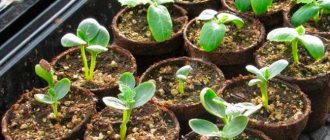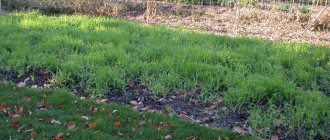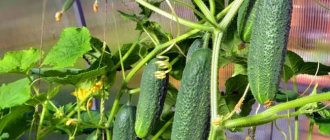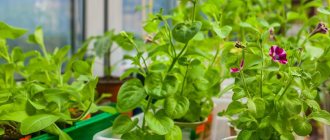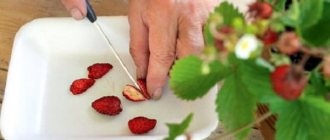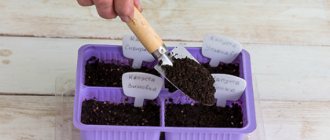Landscape designers often use the Iberis plant when creating flower arrangements; it is easy to grow and you can plant seedlings from seeds at home.
This plant from the cruciferous family is popularly nicknamed goldenflower for its unusual delicate and light inflorescences, reminiscent of clouds. Dear readers! For you, we have created communities on social networks in which useful articles and interesting ideas are published several times a day! Subscribe and receive useful content in a convenient format!
How to determine the time of sowing Iberis?
Iberis seeds can be planted either in a warm place for seedlings or immediately in open ground. Seedlings are sown between March and May. Seeds are sown in the ground when the soil is warm enough. As a rule, this is not earlier than mid-April, or even in May.
Some gardeners plant Iberis before winter. From such seeds, hardened plants grow in the spring, which bloom in April and bloom throughout the spring.
Prices
Another question that concerns gardeners is the price of Iberis, soil and fertilizing for it. Currently, the cost varies within the following limits:
- for Iberis seeds: from 15 to 218 rubles per package. The cost largely depends on the variety;
- for double superphosphate - from 75 to 135 rubles per package of one kilogram;
- for Reasil feeding - from 100 to 250 rubles, the cost depends on the volume of the container.
Iberis can become a real decoration for a garden or a local area; it will fit well into the landscape design and make it unique
The main thing is to plant the seedlings correctly, care for them and transplant them into open ground in a timely manner.
How to prepare planting material for sowing
In order to grow healthy seedlings from seeds, you need to collect and store them correctly. All summer long, as the pods ripen, flower growers collect them, dry them and extract the seeds from them, which are then stored in a dark, dry and cool place.
To make the seeds germinate faster, you can soak them in a weak solution of potassium permanganate before planting. You can also add a few drops of a growth stimulator (Epin is possible). They do it like this:
- The gauze is placed in several layers in a container. Lay out the seeds and cover with another layer of gauze.
- Fill with a solution at room temperature.
- Wrap it in film to create a greenhouse effect and leave it indoors at a temperature of 20-25˚C.
This procedure allows you to get healthier seedlings in a short time.
NOTABLE. Iberis reproduces well by self-sowing, if you do not cut off the shoots after flowering. Only the inflorescences of such plants become much smaller, and their color becomes mostly white, regardless of what it was before.
Diseases and pests
Iberis are classified as cruciferous. Therefore, they are susceptible to the same diseases as other members of this family.
Fungus
Wallflowers have rather sensitive rhizomes and are susceptible to the fungus Plasmodiophora brassicae, which deforms the underground part of the plant. At the same time, growth slows down, and over time the bush dies. To prevent the infection from spreading, diseased plants are removed in a timely manner.
Iberica rhizomes are affected by a fungus
Mealybug
The mealybug is considered the most dangerous for Iberica. When infected, the plant looks drooping and loses turgor due to the fact that the pest feeds on juices.
A mealybug infestation is easily recognized by a white coating resembling flour, as well as sticky mucus called honeydew. The parasite itself is a small insect with a white oval body.
Several home remedies are effective against mealybugs:
- Soap solution. For 1 liter of water take 15 g of soap, you can also add 2 tablespoons of vodka. The plants are sprayed with the product, and after a day they are washed with water. Repeat the procedure three times, with an interval of 7 days.
- Garlic infusion. 6 cloves of garlic are poured with boiling water and left for 4 hours. The infusion is filtered and the ground part of the bush is treated with it.
Among the ready-made insecticides on sale are Aktara, Aktellik, Bi-58, and Aplaud. The pest can also be destroyed in a harmless way - for example, by populating the area with ladybugs and lacewings.
Mealybug is a dangerous pest
Cruciferous flea beetle
These pests appear at air temperatures above 15 °C. They eat young greens, and the larvae damage the roots. With a massive attack, the plant dies in 2–3 days.
Dry spraying will save you from fleas
Attention! Preventive measures should be taken immediately after the seedlings are planted in the ground.
Dry spraying helps in the fight against insects. To do this, pour wood ash and fluff lime, mixed in equal parts, or ash and tobacco dust into a gauze bag. One of these mixtures is sprayed through gauze onto the flowerbed in the early morning, when there is still dew on the plants, and also onto the ground between the rows.
Iberis can be planted on the windowsill
With proper care, your garden plot will always be blooming and fragrant thanks to Iberis. But if you want the bush to please your apartment, then one of the perennial varieties can be planted in a flowerpot. Even in such “cramped” conditions, the plant feels great.
Iberis varieties, which one is better to choose
There are about 40 varieties of Iberis. They differ in the shape and color of the inflorescences (white, blue, pink, red and purple), the type of shoot (creeping or erect), there are annuals and perennials.
Among the annuals, two types of Iberis can be distinguished, cultivated by gardeners:
- Iberis is bitter. Flower color is purple or white. The shape of the inflorescences is columnar. The most common varieties: “Weise Risen”, “Hyacintenblütige Risen”, “Tom Thumb”
- Iberis umbellata . A taller plant. The shoots are smooth, the flowers are of various colors, and have a rather strong pleasant aroma. Blooms for 1.5 months. Popular varieties: “Red Rash”, “Fairy Mixtche”.
Among the perennial varieties of Iberis, the following are cultivated:
- Iberis evergreen. Height up to 30 cm. Glossy foliage. The flowers, often white, form close clusters. Loves well-drained soil. Drought resistant. Varieties: “Snowflake”, “Little Jam”.
- Iberis Gibraltar. The foliage is dark green, the inflorescences are fragrant with varying colors from bright to light at the top. Popular variety “Candy Tuft”, “Gibraltar Candytuft”.
- Iberis Crimean. Lilac flowers. The leaves have fluff.
- Iberis is rocky. The flowers are white with a pinkish tint. Very lush flowering.
general description
The genus of herbaceous plants Iberis belongs to the Brassicaceae family. Its closest relatives are alyssum, rezuha, horseradish, rapeseed, cabbage, leftover, radish, mustard, and marinum.
The genus includes about 40 annual and perennial species, originating from Southern Europe and Asia Minor. Most of them grow in the mountains. On the territory of Russia and neighboring countries, the culture is found in the Crimea, the lower reaches of the Don, and the Caucasus.
From a botanical point of view, the species include herbs, subshrubs, and shrubs. Some perennial Iberis are evergreen or semi-evergreen.
Reference! Shrub is not an affectionate name, but a form of woody plant, characterized by its small growth (several tens of cm) and the absence of a main shoot (trunk).
Depending on the species, variety and growing conditions, the height of Iberis ranges from 10 to 50 cm. The shoots are strong, erect or creeping with ascending ends, covered with juicy, whole or pinnately dissected elongated leaves of a dark green color.
The flowers are small, with a zygomorphic corolla - containing two long and short petals, collected in numerous umbrella inflorescences, completely covering Iberis. Most often they are white, but can be pink, purple, or lilac.
The strong honey aroma of Iberis attracts bees. Flowering is from May to August, lasting about two months, usually longer for annual species. The seeds are small, round or oval, protected by a bivalve, flattened pod. Germination lasts for about 5 years, 1 g contains up to 450 pieces.
Iberis general view
Common Perennial Species
Iberis is thermophilic; most species require shelter for the winter. In gardening, the most widespread are:
- Evergreen Iberis forms a shrub 30-40 cm high with white fragrant inflorescences 5 cm in diameter and whole elongated leaves, withstands temperatures down to -23 ° C;
- Gibraltar Iberis is a semi-evergreen shrub 25 cm high, growing to the sides by 40 cm, blooms in spring, is thermophilic, winters poorly in Russia and is usually grown in a two-year crop;
- Rocky Iberis - blooms in spring, forms dense cushions 10-15 cm high, requires shelter for the winter, but is not as delicate as the previous species;
- Crimean Iberis - distinguished by gray-green leaves and purple, whitening flowers when fully blooming, grows up to 5-10 cm, requires the presence of calcium in the soil.
All perennial species have decorative varieties with flowers of various colors. Iberis Evergreen is most often grown in Russia, as it can withstand low temperatures well.
Common Perennial Species
Popular annual species
Over the course of a year, annual Iberis bushes grow greatly and cover a large area. In Russia and neighboring countries they grow:
- Umbrella Iberis is a well-branched plant about 40 cm high with white or purple flowers collected in dense corymbs, the buds open 4-6 weeks after emergence, the leaves are lanceolate;
- Bitter Iberis forms an erect branching bush about 30 cm high, the flowers are white or with a slight purple tint, collected in umbels up to 2 cm in diameter, stand well when cut, the leaves are jagged along the edge.
Annual species have many varieties, differing in height and color of flowers.
Annual species of Iberis
When to sow Iberis seedlings in 2022, depending on the month
To grow strong and healthy seedlings, some gardeners use the lunar calendar. It is believed that the Moon's magnetic field affects the growth and development of plants.
- In January
— 6, 7, 16, 17, 21, 22, 23, 24, 25, 26 - In February
– 3, 4, 12, 13, 14, 17, 18, 19, 20, 21, 22, 23 - In March
– 11, 12, 13, 16, 17, 19, 20, 21, 22, 23, 24, 29, 30, 31 - In April
– 8, 9, 13, 14, 15, 17, 18, 26, 27 - In May
– 5, 6, 7, 10, 11, 12, 13, 14, 15, 23, 24
Care after flowering
To preserve the aesthetic appearance of the plantings after flowering, it is necessary to trim the stems - at least 1/3 of them are removed. The pods that form in place of the flowers can be collected for seeds. When the plants reach the age of 5–6 years, they need to be replanted, otherwise the inflorescences will become small and sparse, as a result of which the flower bed with Iberis will lose its decorative properties.
Iberis flowers are suitable for cutting; they are often used in floristry
Despite the fact that most varieties of Iberis are frost-resistant plants, in temperate and harsh climates it is better to properly prepare them for winter.
In the southern climate, in the last ten days of autumn, it is enough to add a little compost to the soil around the plantings - it is important not to overdo it, otherwise the bushes will subsequently grow too much.
If Iberis grows in regions with harsh, snowless winters, the plantings should be covered with fallen leaves, spruce branches or dry brushwood sprinkled with a small amount of hay.
When to plant depending on the region
The timing of sowing crops can vary greatly depending on the area of growth. It is worth taking into account the climatic features of the region.
In Moscow and Moscow region
Summers here are warm, winters are moderately cold. But there is a high probability of climate change. Planting Iberis seeds for seedlings takes place from late March to early May. Young shoots need to be planted in the ground no earlier than the end of May in order for the growing of seedlings to be successful.
In the Middle Zone
In the spring, mail in this region warms up slowly and takes a long time to dry out, which can have an extremely negative impact on the growth of seedlings when planted and grown in open ground. Flower growers recommend planting seeds in this region before winter.
In the Urals
The climate here is quite harsh. Precipitation is unevenly distributed. Therefore, the timing of sowing seeds and seedlings may shift 1-2 weeks later compared to the middle zone.
In Siberia
Winter in the region is very cold. Summers are cool and there is little precipitation. It is difficult to call such conditions favorable for flower crops. Iberis is grown here mainly as seedlings. Seeds are sown in April, and young shoots are planted in open ground in early June.
In the Leningrad region
This region experiences high rainfall and low solar heat input. As a result, moisture from the soil evaporates slowly, which is why growing flowers by seedlings is common here. But in general, the climate of the Leningrad region is not much different from the climate of the middle zone. Therefore, the timing of sowing seeds and seedlings of Iberis will be the same here: from March to May.
Reproduction methods
Basically, the annual umbrella iberis is propagated by seeds. However, if desired, you can also use the cutting method. The diagram looks like this:
- After flowering, shoots up to 5 cm are cut from a strong, healthy plant.
- The cuttings are dipped in a growth stimulator and planted in the ground or in a greenhouse.
- Throughout the season, water the plants from time to time until the autumn cold.
Although umbrella iberis from cuttings takes root very easily and quickly, this method is rarely practiced. In the fall, the annual plant, one way or another, dies. It is much more convenient to sow the crop in the right places in the garden with seeds. In this case, it will bloom brightly from late spring and most of the summer.
How to choose a container for planting
To sow Iberis, you can take a large plastic container. The seeds are very small, so it is difficult to plant them in different pots. In this case, it will be necessary to pick the seedlings. As soon as 2 leaves appear, you can start planting.
But it is known that this culture does not tolerate transplantation well. It has a long spine that is easily damaged. To avoid loss of seedlings, it is better to take many small individual containers.
Planting Iberis seeds step by step
The crop is sown for seedlings within a month of planting in open ground. The procedure is as follows:
- Prepare the soil and spread it into containers. It is best to buy a ready-made mixture for seedlings. It is disinfected and fertilized. If this is not possible, the soil needs to be warmed up and treated with a weak solution of potassium permanganate.
- Moisten the soil and plant the seeds, compacting them slightly with the palm of your hand. You can lightly sprinkle a thin layer of soil on top.
- Moisten the crops using a spray bottle with water at room temperature.
- Cover containers with glass or film to retain moisture.
- Place in a warm and well-lit place. The air temperature in the room should be 15-18 ˚С.
It is worth planting seedlings in the ground when they reach a height of 7 cm. This is done by transshipment, that is, without disturbing the lump of earth around the measles system, since this crop is painful to transplant.
Possible problems when growing a flower
As already mentioned, Iberis loves a warm, illuminated place and well-drained soil. If the plant does not like the conditions or care, then various problems appear, which include:
- fungal diseases;
- pests, in particular mealybug and cruciferous flea beetle;
- diseases of the root system: due to the abundance of moisture, it begins to rot;
- diseases of buds and foliage.
Mealybug - white coating on shoots.
Treated with garlic infusion, Mospilan, Aktara. Solving these problems is not difficult. It is enough to promptly remove or treat infected plants, replant healthy ones in a new place, and also treat the soil with special solutions.
At what depth to plant
Loamy, rocky or sandy soil is suitable for sowing Iberis in the ground. The seeding depth is 5-10 mm.
IMPORTANT! The culture does not like acidic soil. Therefore, you need to either avoid such areas or lime them before planting.
The culture is also demanding of light. In shaded areas, the stems stretch and the buds dry out quickly. She also does not like stagnant water. Therefore, a well-lit and loose bed is the best place for sowing crops.
Suitable site
Iberis is a sun-loving plant. In nature, it lives on rocky and sandy loam, breathable soils. Even in light shade it withers away. Also, areas with temporary and especially permanent stagnation of water are contraindicated for it.
Iberian is great for alpine slides
This flower crop does not tolerate proximity to tall shrubs and trees that create shade. With a lack of sunlight, flowering is poor or absent altogether. At the same time, these shrubs go well with many ornamental plants.
Attention! If you want to preserve the purity of the variety, then it is better not to do group plantings. Adjacent bushes quickly cross-pollinate.
In order for the plant to please with its color longer, sowing is carried out in several stages, with a difference of 14 days.
How to plant in peat tablets
Peat tablets are perfect for growing Iberis seedlings. To do this you need to wet them well. When swelling, the tablets increase in volume several times. Then you need to put the seeds (one at a time) into the recesses and sprinkle a little peat on top. Place the tablets in the seedling box, having previously wrapped them in film.
Young shoots should be planted in a flowerbed together with the tablet, cutting its protective film so that it does not interfere with root growth.
This method will protect the seedlings from certain diseases (blackleg).
How to care for Iberis seedlings, what tricks
Iberis is an unpretentious crop and does not require special care. However, following certain rules will allow you to grow strong seedlings, which will ensure lush flowering of an adult plant.
If the seedlings are grown in a large container, as soon as the Iberis seeds have sprouted, they need to be discharged so that the distance between the sprouts is 12-15 cm. As soon as they have a few leaves, you can pinch the top so that the adult plant is bushier. At this stage, good lighting is extremely important for seedlings.
Plants need to be watered regularly with a spray bottle and fed. Any complex fertilizer for seedlings of flower crops is suitable for this, preferably in liquid form. Before planting in the ground, shoots can be sprayed with the adaptogen “Epin” for better plant survival.
This crop has a taproot system. Therefore, when picking, it is extremely important not to damage it. Young shoots need to be replanted together with a lump of earth, using the transshipment method. After picking, you need to monitor the soil moisture, irrigating it moderately.
Answers to frequently asked questions
Which soil to buy for seedlings?
Answer: special soil for seedlings.
How can you stimulate seed germination?
Answer: by soaking and treating with growth stimulants.
Why don't the seeds germinate?
Answer: improper storage affected germination, temperature conditions were violated, and sowing rules were violated.
Why do seeds soak before sowing?
Answer: for faster germination and disinfection.
How to harden seedlings?
Answer: starting from 2-4 days after germination, take it out to the balcony or fresh air for a while.
What to do if the seedlings don't grow?
Answer: use growth stimulants, observe what caused the growth to stop (excessive watering, low light).


